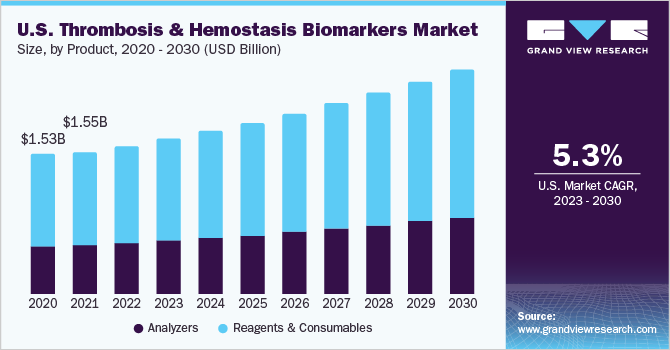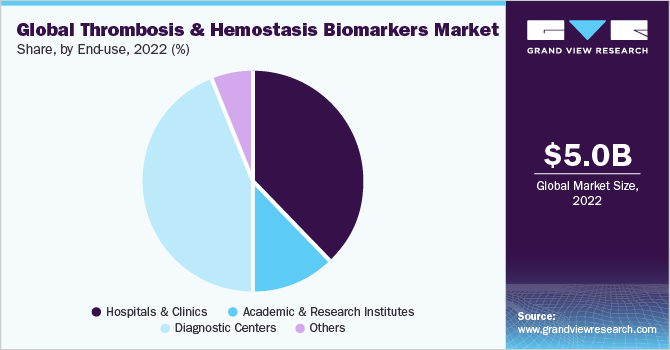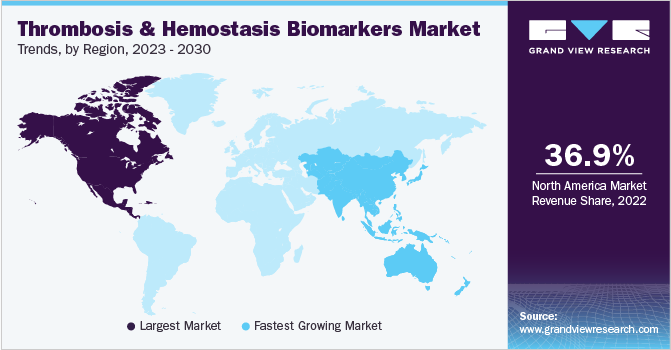- Home
- »
- Clinical Diagnostics
- »
-
Thrombosis And Hemostasis Biomarkers Market Size ReportGVR Report cover
![Thrombosis And Hemostasis Biomarkers Market Size, Share & Trends Report]()
Thrombosis And Hemostasis Biomarkers Market Size, Share & Trends Analysis Report By Product (Analyzers, Reagents & Consumables), By Test Location, By Test Type, By Application, By End-use, By Region, And Segment Forecasts, 2023 - 2030
- Report ID: GVR-4-68040-081-8
- Number of Report Pages: 180
- Format: PDF, Horizon Databook
- Historical Range: 2018 - 2021
- Forecast Period: 2023 - 2030
- Industry: Healthcare
Report Overview
The global thrombosis and hemostasis biomarkers market size was valued at USD 5.01 billion in 2022 and is expected to grow at a compound annual growth rate (CAGR) of 5.9% from 2023 to 2030. The market growth is attributable to the increasing prevalence of chronic diseases such as pancreatic cancer, expanding base of the geriatric population, the growing demand for personalized medicines, and overall advancements in technology. The market was also positively impacted by the spread of COVID-19. As per the National Library of Medicine, in September 2020, thrombotic complications were frequent in COVID-19 patients and contributed to high mortality and morbidity. The increased awareness created by the pandemic also created significant new opportunities for market players.

Biomarker test results for thrombosis help in articulating treatment for high-risk patient pools. For instance, according to the American Heart Association, in August 2020, laboratory biomarker testing suggested a 30% prevalence of thrombotic events in hospitalized COVID-19 patients. Furthermore, D-Dimer biomarker tests allowed to screen for thrombosis risk in COVID-19 patients, thereby, positively impacting the market.
The increasing prevalence of chronic diseases such as pancreatic cancer, deep vein thrombosis (DVT), and pulmonary embolism (PE) have become major contributors to the growth of the thrombosis and hemostasis biomarkers market. As per the World Cancer Research Fund International in 2020, pancreatic cancer was termed the 12th most common form of cancer globally. Nearly 495,000 new cases of pancreatic cancer were reported in 2020, with an ASR of 4.9 per 100,000 people. Thrombosis and hemostasis biomarkers are readily used to diagnose and assess the risk of thrombotic events in patients with pancreatic cancer, as various chemotherapy agents used in treating cancer increase the risk of thrombotic events.
The increasing demand for personalized medicines is projected to drive the thrombosis and hemostasis biomarkers market. The biomarkers allow healthcare providers to develop personalized treatment plans which are more effective and safer for every individual. Personalized medicines work on the principle of curating personalized medical treatment for individuals with unique genetic makeup and medical history; thereby, thrombosis and hemostasis biomarkers help identify patients at an increased risk of blood clots. According to researchers from the Tohoku University of Japan, complications related to blood clots for people with IBD or inflammatory bowel disease can be prevented using a newly found combination of genetic markers. This ailment affects as many as 2,10,000 people in Japan today.
Based on the promise of biomarkers and personalized medicine, the British Heart Foundation has funded research into the arena to transform heart treatments. According to its publication, new funding in personalized medicine can transform heart treatment in 4 key ways. These include creating digital hearts to predict treatment success, designing personalized pacemakers, preventing heart attacks & strokes with personalized medicine, and predicting the impact of chemotherapy on the heart.
Novel technologies are being built to curate more sensitive and specific biomarkers that can detect small changes in the clotting and hemostasis systems. For example, mass spectrometry and other high-throughput proteomics technologies have evolved, allowing to identify new, previously undetectable biomarkers.
New technologies are enabling the development of more sensitive and specific biomarkers that can detect small changes in the clotting & hemostasis systems. For example, the use of mass spectrometry and other high-throughput proteomics technologies has led to the identification of new biomarkers that were previously undetectable, providing more comprehensive information about a patient's clotting and hemostasis status.
Additionally, new product developments with advanced technologies are anticipated to have a positive impact on the market. For instance, in May 2022, Precision BioLogic made its CRYOcheck Chromogenic Factor IX test available in Canada, which indicates its availability in Canada along with the EU, New Zealand, & Australia. CRYOcheck chromogenic assay is the only FIX assay approved by Health Canada and used for the diagnosis of Hemophilia A.
Product Insights
The reagents & consumables segment held the largest market share of 65.40% in 2022 in the hemostasis and thrombosis biomarkers market and is estimated to become the fastest-growing segment over the forecast period. The dominant segment share can be attributed to the growing prevalence of bleeding and coagulation disorders, high demand for diagnostic tools, and new product launches. For example, in March 2019, HORIBA UK Ltd announced a product launch of a specific D-dimer parameter, which will be applicable in the instrument range of Yumizen G. The parameter will be known as GDDi 2 (D-Dimer), which also includes compact coagulation analyzer called Yumizen G200.
The analyzer segment is expected to grow at a significant CAGR over the forecast period. The segment’s growth can be attributed to the increasing prevalence of bleeding disorders and coagulation disorders and technological advancements in diagnostic tools. Advancements in this area continue to make way in the industry. For instance, in December 2022, Hemo-Sonics announced the FDA approval of its blood analyzer system for the determination of blood clotting during liver transplantation and trauma procedures.
Test Location Insights
The clinical laboratory test segment held the largest share of 62.17% in the thrombosis & hemostasis biomarkers market in 2022. Clinical laboratory tests help identify abnormalities within the blood clotting process, determine the severity of the condition, and guide treatment decisions. Moreover, the increasing investment in healthcare infrastructure, particularly in emerging economies, is also driving the growth of the clinical laboratory tests segment. For instance, as per Niti Aayog’s National Health Accounts (NHA) 2022, India’s government health expenditure represents 1.28% of its total GDP, an increase from 1.15% in 2013-14. As healthcare systems become more sophisticated and accessible, more people can access diagnostic tests, including clinical laboratory tests, leading to an increased demand for thrombosis and hemostasis biomarkers tests.
Point-of-care tests (POCT) are estimated to grow at the fastest rate over the forecast period. Point-of-care test segment growth can be attributed to the convenience it provides to healthcare providers, as POC tests can provide results within minutes. POCT allows diagnostic tests to be performed in settings outside traditional clinical laboratory settings, such as doctor's offices, emergency rooms, or even in patients' homes, thereby, driving the thrombosis and hemostasis biomarkers industry. Furthermore, geographic expansion by market players will help in curating demand for the POC tests. In November 2022, Entegrion, Inc., which has expertise in the management and clinical diagnosis of hemostasis, announced an expansion in Europe. The company launched Entegrion Italia for its European business.
Test Type Insights
Post-Thrombin (PT) test segment held the largest share of 17.65% in the thrombosis & hemostasis biomarkers market in 2022. The test allows to monitor the effectiveness of anticoagulant medications, such as warfarin, used to prevent blood clots. It is also utilized as a diagnostic tool to identify bleeding disorders or liver diseases. Blood plasma typically takes approximately 11 to 13.5 seconds to clot for individuals not taking blood thinning medications. PT tests are often presented as an International Normalized Ratio (INR) that typically ranges from 0.9 to 1.1. For people with warfarin, the target INR range is usually between 2 and 3.5, which is higher than the normal range.
Fibrin/ fibrinogen is estimated to be the fastest-growing segment of the thrombosis & hemostasis biomarkers market over the forecast period. The test is performed to manage and assess medical conditions such as blood clot formation, which include DVT, PE, and other thrombotic disorders. Furthermore, it is also useful in detecting deficiencies in fibrinogen levels, caused by genetic or hereditary factors. Different types of fibrinogen deficiencies include Afibrinogenemia, Hyperfibrinogenemia, and Dysfibrinogenemia. Afibrinogenemia is a rare disease affecting only 1 in every 1 million people and refers to a complete absence of fibrinogen in the blood.
Application Insights
Deep Vein Thrombosis (DVT) held the largest share of 40.33% in 2022 for the thrombosis and hemostasis biomarkers market. Deep vein thrombosis is a serious and underdiagnosed disease that develops a blood clot in a deep vein most commonly in the pelvis, lower leg, thigh, and arm. DVT cases are estimated at 1-2 cases per 1,000 people annually. It affects people from all ethnicities, gender, and age, but certain people remain at higher risk. This includes factors such as people with a history of blood clots, family history, obesity, cancer, and other chronic diseases.
Pulmonary embolism (PE) is expected to grow at a significant CAGR over the forecast period. Pulmonary embolism is a disease caused by blood clots in the blood vessels in the lungs, which can also occur in other body parts such as arms or legs. PE is one of the most common heart diseases, ranking only behind stroke and heart attack. For instance, as per American Lung Association in January 2023, PE affects nearly 900,00 people in the U.S. annually. Pulmonary embolism can be diagnosed via a D-dimer test, computed tomography angiogram, ultrasound, and V/Q scan.
End-use Insights
Diagnostic centers held the largest market share of 44.32% in 2022 in the thrombosis and hemostasis biomarkers market. The share can be attributed to an improved reliance of hospitals on diagnostic laboratories for testing & evaluation, which further leads to accelerated growth of the segment. Another major factor expected to drive segment growth is the increase in government initiatives to provide various facilities, such as compensation for diagnostic tests. Moreover, several healthcare institutions are working with laboratories to incorporate different clinical tests, such as thrombosis & hemostasis biomarkers testing. For instance, in May 2023, Labcorp entered into a strategic agreement with Jefferson Health, through which the former will acquire the latter’s outreach for laboratory services. Additionally, with this strategic move, Jefferson will be able to expand its specialty lab testing.

Hospitals and clinics are expected to grow at a lucrative growth in the thrombosis & hemostasis biomarkers market. Constant changes in the healthcare industry have led to a rise in the need for hospitals with improved diagnostic services. The increase in healthcare spending globally has significantly contributed to the segment growth. As hospitals collect and maintain data on disease frequency, regulatory bodies often collaborate with hospitals for disease surveillance. The need for hospitals with advanced facilities has increased with ongoing changes in the healthcare industry. The rise in the number of hospitals and diagnostic laboratories has also led to high growth in the segment.
Regional Insights
North America held the largest share of 36.99% in the thrombosis and hemostasis biomarkers market in 2022. It can be attributed to an increasing prevalence of thrombosis and hemostasis disorders, advancements in technology, and consistent R&D efforts in thrombosis and hemostasis biomarkers are key factors driving the market in the region. For instance, the estimated annual incidence of Venous Thromboembolism (VTE) in the region ranges from 104 to 183 cases per 100,000 population per year. Furthermore, within the U.S., 10% to 30% of patients in the ICU develop disseminated intravascular coagulation. Lastly, growing demand for personalized medicines and favorable government initiatives propel the hemostasis & thrombosis industry in the region.

Asia-Pacific is estimated to register the fastest growth in the thrombosis & hemostasis biomarker market over the forecast period attributed to the local presence of leading companies and increased R&D investment. Furthermore, the growing geriatric population susceptible to diseases and rising prevalence of cardiovascular diseases and blood clotting disorders, are anticipated to propel the Asia Pacific regionalmarket. For instance, according to research published in Science Direct, there were 18.6 million CVD deaths globally in 2019, of which, 58% occurred in Asia Pacific. Favorable reimbursement policies in the Asia Pacific for thrombosis & hemostasis biomarker testing are influencing the market in the region.
Key Companies & Market Share Insights
The key players operating in the thrombosis & hemostasis biomarkers industry are constantly focusing on introducing and changing existing technologies that enhance patient outcomes and significantly increase the effectiveness and efficiency of healthcare. For instance, in March 2023, F. Hoffman-La Roche Ltd collaborated with Eli-Lily and Company to support the Elecsys Amyloid Plasma Panel (EAPP) development. The partnership is anticipated to enhance the company’s thrombosis and hemostasis biomarkers portfolio. Some prominent players in the thrombosis and hemostasis biomarkers market include:
-
bioMérieux SA
-
F. Hoffmann-La Roche Ltd.
-
Biomedica Diagnostics
-
Siemens Healthineers
-
Abbott
-
HORIBA Ltd.
-
Werfen
-
Quidel Corporation
-
Diazyme Laboratories, Inc.
-
Thermo Fisher Scientific, Inc.
Thrombosis And Hemostasis Biomarker Market Report Scope
Report Attribute
Details
Market size value in 2023
USD 5.27 billion
Revenue forecast in 2030
USD 7.92 billion
Growth rate
CAGR of 5.9% from 2023 to 2030
Base year for estimation
2022
Historical data
2018 - 2021
Forecast period
2023 - 2030
Quantitative units
Revenue in USD million/billion, CAGR from 2023 to 2030
Report coverage
Revenue forecast, company ranking, competitive landscape, growth factors, and trends
Segments covered
Product, test location, test type, application, end-use, region
Regional scope
North America; Europe; Asia Pacific; Latin America; MEA
Country scope
U.S.; Canada; Germany; UK; France; Italy; Spain; Denmark; Sweden; Norway; Rest of Europe; China; Japan; India; Australia; South Korea; Thailand; Rest of Asia Pacific; Brazil; Mexico; Argentina; Rest of Latin America; South Africa; Saudi Arabia; UAE; Kuwait;Rest of Middle East and Africa
Key companies profiled
Thermo Fisher Scientific, Inc.; F. Hoffmann-La Roche Ltd.; Siemens Healthineers; Abbott; bioMérieux SA; Werfen; HORIBA Ltd; Quidel Corporation; Diazyme Laboratories, Inc.; Biomedica Diagnostics.
Customization scope
Free report customization (equivalent up to 8 analysts’ working days) with purchase. Addition or alteration to country, regional & segment scope.
Pricing and purchase options
Avail customized purchase options to meet your exact research needs. Explore purchase options
Global Thrombosis And Hemostasis Biomarkers Market Report Segmentation
This report forecasts revenue growth at global, regional, & country levels and provides an analysis of the latest industry trends in each of the sub-segments from 2018 to 2030. For the purpose of this report, Grand View Research has segmented the global thrombosis and hemostasis market report based onproduct, test location, test type, application, end-use, and region:
-
Product Outlook (Revenue, USD Million, 2018 - 2030)
-
Analyzers
-
Reagents & Consumables
-
-
Test Location Outlook (Revenue, USD Million, 2018 - 2030)
-
Clinical Laboratory Tests
-
Point-of-Care Tests
-
-
Test Type Outlook (Revenue, USD Million, 2018 - 2030)
-
D-Dimer
-
Anti-Thrombin III
-
Plasminogen
-
Soluble Fibrin
-
Selectins
-
Factor VIII
-
PT
-
APTT
-
Fibrinogen
-
Others
-
-
Application Outlook (Revenue, USD Million, 2018 - 2030)
-
Deep Vein Thrombosis (DVT)
-
Pulmonary Embolism (PE)
-
Disseminated Intravascular Coagulation (DIC)
-
Others
-
-
End-use Outlook (Revenue, USD Million, 2018 - 2030)
-
Hospitals & Clinics
-
Academic & Research Institutes
-
Diagnostic Centers
-
Others
-
-
Regional Outlook (Revenue, USD Million, 2018 - 2030)
-
North America
-
U.S.
-
Canada
-
-
Europe
-
UK
-
Germany
-
France
-
Italy
-
Spain
-
Denmark
-
Sweden
-
Norway
-
Rest of Europe
-
-
Asia Pacific
-
Japan
-
China
-
India
-
Australia
-
South Korea
-
Thailand
-
Rest of Asia Pacific
-
-
Latin America
-
Brazil
-
Mexico
-
Argentina
-
Rest of Latin America
-
-
Middle East and Africa
-
South Africa
-
Saudi Arabia
-
UAE
-
Kuwait
-
Rest of the Middle East and Africa
-
-
Frequently Asked Questions About This Report
b. The global thrombosis and hemostasis biomarkers market size was estimated at USD 5.01 billion in 2022 and is expected to reach USD 5.27 billion in 2023.
b. The global thrombosis and hemostasis biomarkers market is expected to grow at a compound annual growth rate of 5.9% from 2023 to 2030 to reach USD 7.92 billion by 2030.
b. Reagents & consumables dominated the thrombosis and hemostasis biomarkers market with a share of 65.40% in 2022. This is attributable to the growing prevalence of bleeding and coagulation disorders, high demand for diagnostic tools, and new product launches.
b. Some key players operating in the thrombosis & hemostasis biomarkers market bioMérieux SA, F. Hoffmann-La Roche Ltd., , Biomedica Diagnostics, Siemens Healthineers, Abbott, HORIBA Ltd., Werfen, Quidel Corporation, Diazyme Laboratories, Inc., and Thermo Fisher Scientific, Inc.
b. Key factors that are driving the market growth include the increasing prevalence of chronic diseases such as pancreatic cancer, expanding base of geriatric population, growing demand for personalized medicines, and overall advancements in technology.
Share this report with your colleague or friend.
![gvr icn]()
NEED A CUSTOM REPORT?
We can customize every report - free of charge - including purchasing stand-alone sections or country-level reports, as well as offer affordable discounts for start-ups & universities. Contact us now
![Certified Icon]()
We are GDPR and CCPA compliant! Your transaction & personal information is safe and secure. For more details, please read our privacy policy.
We are committed towards customer satisfaction, and quality service.
"The quality of research they have done for us has been excellent."





